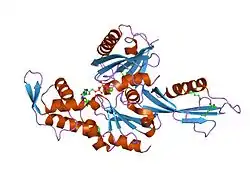FtsA
FtsA (von englisch filamentous temperature sensitive A ‚filamentös temperaturempfindlich A‘) ist ein Protein des Zytoskeletts von Bakterien, mit Ausnahme von Actinobakterien und Cyanobakterien.
| FtsA | ||
|---|---|---|
 | ||
| nach PDB 1e4g | ||
| Masse/Länge Primärstruktur | 45.330 Dalton / 420 Aminosäuren | |
| Bezeichner | ||
| Externe IDs | ||
| Enzymklassifikation | ||
| EC, Kategorie | , ATPase | |
| Substrat | Adenosintriphosphat | |
| Produkte | Adenosindiphosphat und Phosphat | |
Eigenschaften

FtsA dient in Bakterien zur Stabilisierung der Zelle und zur Fortbewegung (Zellmotilität), möglicherweise ist es an der Einleitung der Zellteilung beteiligt.[1] FtsA ist ein Homolog von Aktin und ein Scaffold-Protein,[2] wie auch die Proteine MreB, ParM und MamK. Wie Aktin hydrolysiert FtsA Adenosintriphosphat zur Änderung seiner Konformation und bildet dann strangförmige Aggregate (Mikrofilamente) aus.[3][4]
FtsA ist strukturell ähnlich wie PilM aufgebaut, welches als ATPase des Typs IV in Pili von Bakterien vorkommt.[5] FtsA bindet an FtsZ im Z-Ring[3] und bindet diesen über eine amphiphile α-Helix am C-Terminus des FtsA an die Zellmembran.[6][4] Alternativ kann der C-Terminus auch von MinC und ZipA gebunden werden. An einer anderen Stelle der Proteinoberfläche wird FtsN gebunden.[7][8] FtsZ, FtsA und ZipA sind an der Einleitung der Zellbewegung beteiligt.[9] Während FtsA in Escherichia coli essentiell ist, kann seine Funktion in Bacillus subtilis bei einer Deletion durch SepF teilweise kompensiert werden.[10] Die Mutante FtsA* funktioniert unabhängig von ZipA.[11][12] Andere identifizierte Mutanten besitzen veränderte Multimerisierungseigenschaften.[4] Die Funktionen des FtsA sind über verschiedene Bakterienarten konserviert.[13]
Einzelnachweise
- Geissler B, Shiomi D, Margolin W: The ftsA* gain-of-function allele of Escherichia coli and its effects on the stability and dynamics of the Z ring. In: Microbiology. 153, Nr. Pt 3, 2007, S. 814–823. doi:10.1099/mic.0.2006/001834-0. PMID 17322202.
- van den Ent F, Löwe J: Crystal structure of the cell division protein FtsA from Thermotoga maritima. In: EMBO J. 19, Nr. 20, 2000, S. 5300–5307. doi:10.1093/emboj/19.20.5300. PMID 11032797.
- Szwedziak P, Wang Q, Freund SMV, Löwe J: FtsA forms actin-like protofilaments. In: EMBO J. 31, Nr. 10, 2012, S. 2249–2260. doi:10.1038/emboj.2012.76. PMID 22473211.
- Pichoff S, Shen B, Sullivan B, Lutkenhaus J: FtsA mutants impaired for self-interaction bypass ZipA suggesting a model in which FtsA’s self-interaction competes with its ability to recruit downstream division proteins. In: Mol Microbiol. 83, Nr. 6, 2012, S. 151–167. doi:10.1111/j.1365-2958.2011.07923.x. PMID 22111832.
- Karrupiah F, Derrick JP: Structure of the PilM-PilN inner membrane type IV pilus biogenesis complex from Thermus thermophilus. In: J Biol Chem. 286, Nr. 27, 2011, S. 24434–24442. doi:10.1074/jbc.M111.243535. PMID 21596754.
- Pichoff S, Lutkenhaus J: Tethering the Z ring to the membrane through a conserved membrane targeting sequence in FtsA. In: Mol Microbiol. 55, Nr. 6, 2005, S. 1722–1734. doi:10.1111/j.1365-2958.2005.04522.x. PMID 15752196.
- Rico AI, García-Ovalle M, Mingorance J, Vicente M: Role of two essential domains of Escherichia coli FtsA in localization and progression of the division ring. In: Mol Microbiol. 53, Nr. 5, Sep 2004, S. 1359–1371year= 2004. doi:10.1111/j.1365-2958.2004.04245.x. PMID 15387815.
- Busiek KK, Eraso JM, Wang Y, Margolin W: The early divisome protein FtsA interacts directly through its 1c subdomain with the cytoplasmic domain of the late divisome protein FtsN. In: J Bacteriol. 194, Nr. 8, 2012, S. 1989–2000. doi:10.1128/JB.06683-11. PMID 22328664.
- Rico AI, Krupka M, Vicente M: In the beginning, Escherichia coli assembled the proto-ring: an initial phase of division. In: J Biol Chem. 288, Nr. 29, 2013, S. 20830–20836. doi:10.1074/jbc.R113.479519. PMID 23740256.
- Ishikawa S, Kawai Y, Hiramatsu K, Kuwano M, Ogasawara N: A new FtsZ-interacting protein, YlmF, complements the activity of FtsA during progression of cell division in Bacillus subtilis. In: Mol Microbiol. 60, Nr. 1, 2006, S. 1364–1380. doi:10.1111/j.1365-2958.2006.05184.x. PMID 16796675.
- Geissler B, Elraheb D, Margolin W: A gain-of-function mutation in ftsA bypasses the requirement for the essential cell division gene zipA in Escherichia coli. In: Proc Natl Acad Sci USA. 100, Nr. 7, 2003, S. 4197–4202. doi:10.1073/pnas.0635003100. PMID 12634424.
- Osawa M, Erickson HP: Liposome division by a simple bacterial division machinery. In: Proc Natl Acad Sci USA. 110, Nr. 3, 2013, S. 11000–11004. doi:10.1073/pnas.1222254110. PMID 25213228.
- Fujita J, Maeda Y, Nagao C, Tsuchiya Y, Miyazaki Y, Hirose M, Mizohata E, Matsumoto Y, Inoue T, Mizuguchi K, Matsumura H: Crystal structure of FtsA from Staphylococcus aureus. In: FEBS Lett. 588, Nr. 10, 2014, S. 1879–1885. doi:10.1016/j.febslet.2014.04.008. PMID 24746687.